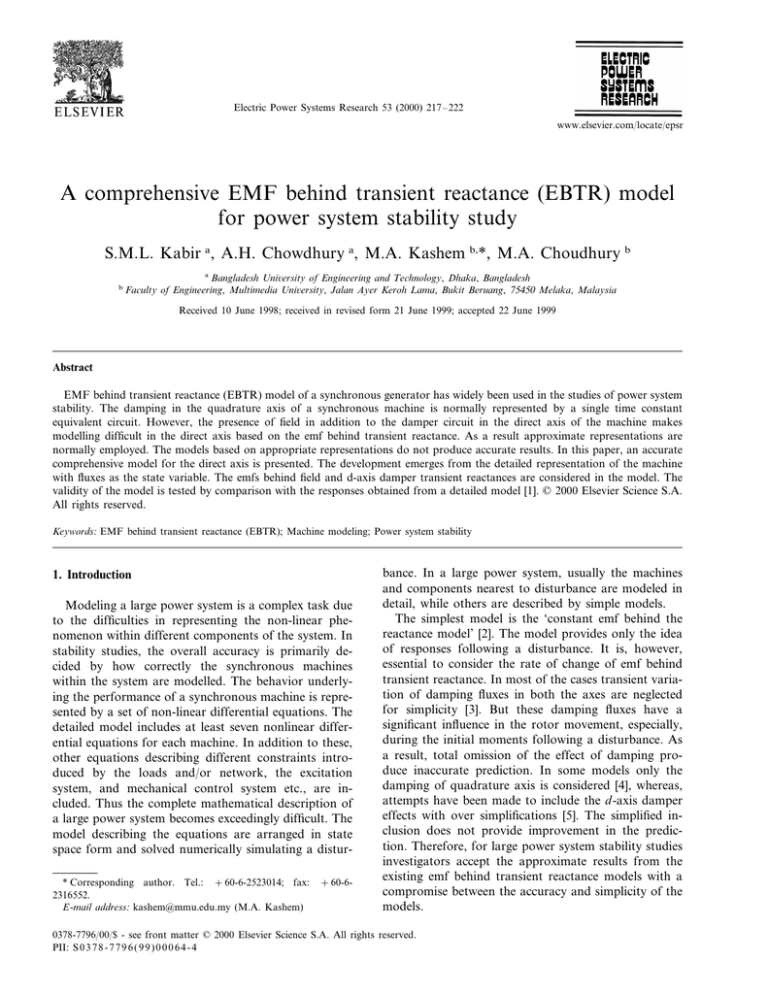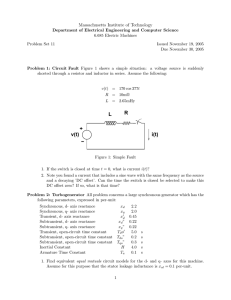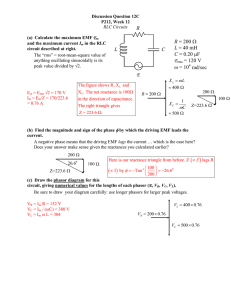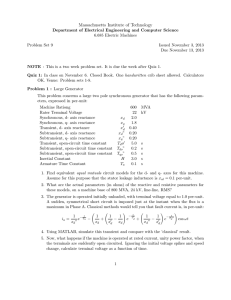
Electric Power Systems Research 53 (2000) 217 – 222
www.elsevier.com/locate/epsr
A comprehensive EMF behind transient reactance (EBTR) model
for power system stability study
S.M.L. Kabir a, A.H. Chowdhury a, M.A. Kashem b,*, M.A. Choudhury b
b
a
Bangladesh Uni6ersity of Engineering and Technology, Dhaka, Bangladesh
Faculty of Engineering, Multimedia Uni6ersity, Jalan Ayer Keroh Lama, Bukit Beruang, 75450 Melaka, Malaysia
Received 10 June 1998; received in revised form 21 June 1999; accepted 22 June 1999
Abstract
EMF behind transient reactance (EBTR) model of a synchronous generator has widely been used in the studies of power system
stability. The damping in the quadrature axis of a synchronous machine is normally represented by a single time constant
equivalent circuit. However, the presence of field in addition to the damper circuit in the direct axis of the machine makes
modelling difficult in the direct axis based on the emf behind transient reactance. As a result approximate representations are
normally employed. The models based on appropriate representations do not produce accurate results. In this paper, an accurate
comprehensive model for the direct axis is presented. The development emerges from the detailed representation of the machine
with fluxes as the state variable. The emfs behind field and d-axis damper transient reactances are considered in the model. The
validity of the model is tested by comparison with the responses obtained from a detailed model [1]. © 2000 Elsevier Science S.A.
All rights reserved.
Keywords: EMF behind transient reactance (EBTR); Machine modeling; Power system stability
1. Introduction
Modeling a large power system is a complex task due
to the difficulties in representing the non-linear phenomenon within different components of the system. In
stability studies, the overall accuracy is primarily decided by how correctly the synchronous machines
within the system are modelled. The behavior underlying the performance of a synchronous machine is represented by a set of non-linear differential equations. The
detailed model includes at least seven nonlinear differential equations for each machine. In addition to these,
other equations describing different constraints introduced by the loads and/or network, the excitation
system, and mechanical control system etc., are included. Thus the complete mathematical description of
a large power system becomes exceedingly difficult. The
model describing the equations are arranged in state
space form and solved numerically simulating a distur* Corresponding author. Tel.: +60-6-2523014; fax:
2316552.
E-mail address: kashem@mmu.edu.my (M.A. Kashem)
+60-6-
bance. In a large power system, usually the machines
and components nearest to disturbance are modeled in
detail, while others are described by simple models.
The simplest model is the ‘constant emf behind the
reactance model’ [2]. The model provides only the idea
of responses following a disturbance. It is, however,
essential to consider the rate of change of emf behind
transient reactance. In most of the cases transient variation of damping fluxes in both the axes are neglected
for simplicity [3]. But these damping fluxes have a
significant influence in the rotor movement, especially,
during the initial moments following a disturbance. As
a result, total omission of the effect of damping produce inaccurate prediction. In some models only the
damping of quadrature axis is considered [4], whereas,
attempts have been made to include the d-axis damper
effects with over simplifications [5]. The simplified inclusion does not provide improvement in the prediction. Therefore, for large power system stability studies
investigators accept the approximate results from the
existing emf behind transient reactance models with a
compromise between the accuracy and simplicity of the
models.
0378-7796/00/$ - see front matter © 2000 Elsevier Science S.A. All rights reserved.
PII: S 0 3 7 8 - 7 7 9 6 ( 9 9 ) 0 0 0 6 4 - 4
S.M.L. Kabir et al. / Electric Power Systems Research 53 (2000) 217–222
218
This paper describes a newly developed comprehensive emf behind transient reactance model which is
derived from the detailed representation of a synchronous generator. Since the development is based on
the same set of equations as used in the development of
detailed state space model, the new model provides
accurate results comparable to results obtained by detailed modelling. The model is represented by emfs
behind fields, d-damper and q-damper transient reactances. The variation of field and d-damper emfs are
found to be coupled with each other and the overall
time constant for flux distribution is determined by field
and damper time constants simultaneously.
X%kd = Xkd + Xf Xmd,
X%d 1 = Xa + Xf Xmd,
X%d 2
= Xa + Xkd Xmd
Tdo 1 =
X%f
,
voRf
Tdo 2 =
X%kd
voRkd
The term E%q 1 may be termed as emf behind field
transient reactance, E%d 1, and E%q 1 as emf behind ddamper transient reactance, X%d 2.
Since only one rotor circuit is normally considered in
the quadrature axis, the expression for emf behind
q-axis transient reactance, X%q can easily be obtained.
The expression is,
T%q0pE%d = − E%d + (Xq − X%q )iq
where,
2. Mathematical formulation
For an alternator, the field and d-axis damper flux
linkages are expressed in terms of currents as,
vocf =Xmdid + Xfdif +Xmdikd
(1)
vockd =Xmdid +Xmdif +Xkddikd
(2)
From Eqs. (1) and (2), the expression for if and ikd can
be obtained as,
if =
Xkdd
X
X X
vocf − md vockd − kd md id
X
X
X
Xfd
Xmd
Xf Xmd
vc −
vc−
i
ikd =
X o kd
X o f
X d
(3)
(4)
where
X =XmdXf +Xf Xkd +XkdXf
During a disturbance, the rate of change of field and
d-axis damper flux linkages are given by
pCf = Uf − Rf if
(5)
pckd = − Rkdikd
(6)
Replacing the expression of if and ikd from Eqs. (3) and
(4) in Eqs. (5) and (6) respectively, the later set of
equations after simplification becomes,
X%
X
X
T%do 1pE%q 1 = f Efd −E%q 1 + md E%q 2 + kd (Xd −X%d 1)id
Xfd
Xfd
Xkdd
(7)
where,
X
X
T%do 2pE%q 2 = − E%q 2 + md E%q 1 + f (Xd −X%d 2)id
Xkdd
Xfd
where,
Efd =Xmd
=
Uf
X
, E%q 1 = md v08f,E%q2
Rf
Xkdd
Xmd
vc ,
Xkdd o kd
X%f =Xf +Xkd Xmd
(9)
(8)
X%q = Xa + Xmq Xkq,
=
E%d =
Xmq
vc ,
Xkqq o kq
T%qo
Xkqq
voRkq
The Eqs. (7)–(9) relate the emf behind the reactances
with the rotor quantities. In order to obtain the relationship for the stator quantities, the expression for dand q-axis component of stator voltage are analyzed.
The expressions are,
Vd = pcd + vocq + Raid
(10)
Vq = pcq − vocd + RaiQ
(11)
In most of the power system stability studies, the pcd
and pcq are normally omitted. These terms are responsible for the dc components of phase voltage and
currents and alternating component of electrical torque.
Of course, a compensation for the omission needs to be
incorporated for accurate prediction of dynamic movement of rotor following a disturbance [6].
Eqs. (10) and (11) can be expressed in terms of
currents by replacing if and ikd of Eqs. (3) and (4) in
Eqs. (10) and (11). After this replacement and simplification the equation becomes as follows,
Vd = X%qiq + E%d + Raid
Vq = − X¦did −
(12)
(X¦d − Xa )
(X¦ − Xa )
E% − d
E% + Raiq
X%d 1 − Xa q 1 X%d 2 − Xa q 2
(13)
where, X¦d = Xa + Xmd Xf Xkd.
The relationship between the terminal voltages and
the component of infinite bus bar voltage are expressed
as,
Vbd = Vd + Xiq + Rid
(14)
Vbq = Vd − Xid + Riq
(15)
where, R and X are the line resistance and inductive
reactance respectively.





